The 8 Best Warehouse Management Software for 2025
Date
Oct 23, 25
Reading Time
12 Minutes
Category
Low-Code/No-Code Development
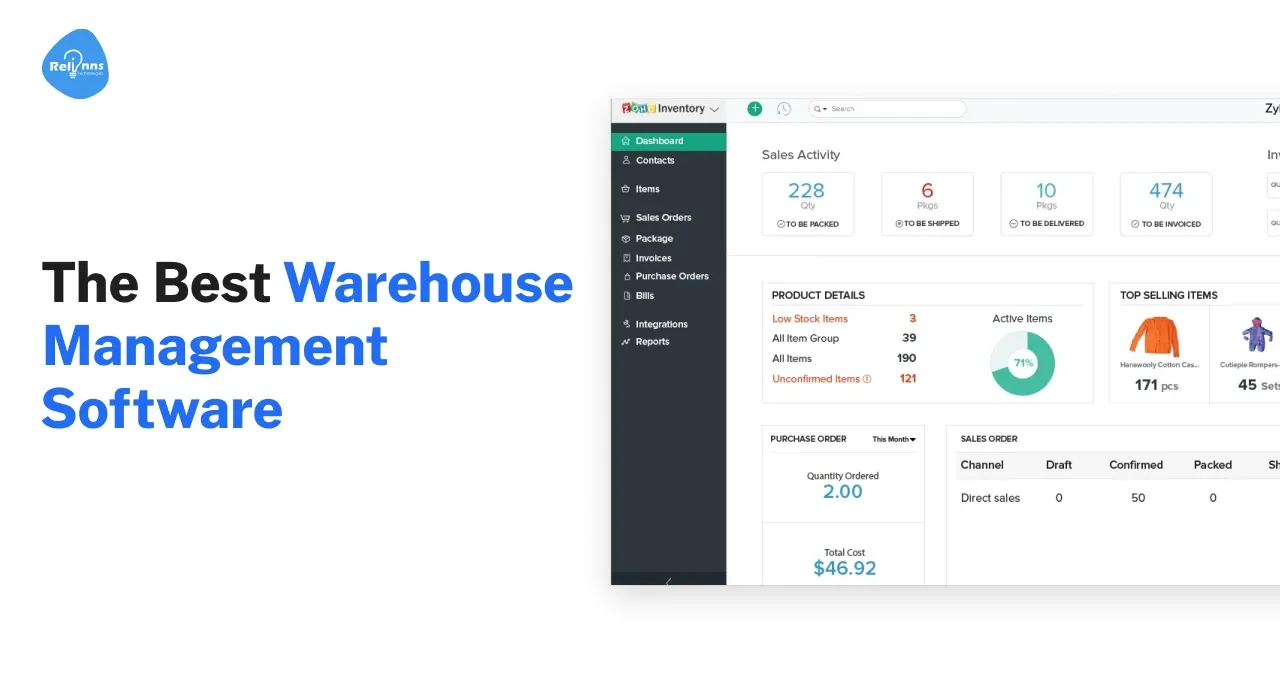
Ever wonder why some warehouses run like clockwork while others constantly struggle to keep up? It’s not always about size or budget; it’s about how well things are managed behind the scenes.
That’s where Warehouse Management Softwares make all the difference. They bring together everything from inventory management and order fulfillment to logistics optimization and delivery tracking, all in one system.
With the right tools, warehouses can finally eliminate errors, optimize and speed up delivery, and keep operations running smoothly.
In this guide, we’ll explore the 8 best warehouse management software for 2025, so you can find the one that fits your business and keeps your warehouse ahead of the curve.
Top 8 Warehouse Management Software
Finding the right Warehouse Management Software can make the difference between an efficient operation and a chaotic one.
But you don’t have to worry. We have sorted everything out for your ease.
Comparison Table of Warehouse Management Software
Given below is a comparison table of the top solutions leading the way in 2025, each offering unique strengths to streamline your warehouse operations and boost productivity.
| Name of Software | Features | Pricing |
| Blue Yonder | AI-driven slotting, resource orchestration, yard & dock integration, low-code customization, automated tasking, unified supply chain view, cloud scalability | Custom quote based on modules and scale. |
| Infor WMS | 3D visualization, voice-directed picking, AI slotting, labor management, 3PL multi-tenancy, TMS integration, cloud/on-premise flexibility | Custom pricing based on modules and users. |
| Fishbowl | Barcode & QR scanning, automated reordering, packing tools, Fishbowl Go mobile app, QuickBooks & Xero sync, ShipExpress integration, multi-warehouse support | $199 – $699/month, with custom plans available. |
| Zoho Inventory | Multi-channel sync, barcode management, batch tracking, custom workflows, carrier integrations, warehouse monitoring, automation tools | $39 – $299/month, based on plan. |
| Extensiv 3PL Warehouse Manager | Client portal access, automated billing, EDI/API integrations, mobile scanning, carton optimization, multi-warehouse control, analytics dashboard | $100 – $1,000/month, plus ~$35/month account management fee. |
| Ascent WMS | WES/WCS integration, 3PL management, wave & replenishment planning, task interleaving, labor tracking, storage configuration, automation interface | Custom pricing based on warehouse size and automation level. |
| Blue Link ERP | Barcode scanning, multi-warehouse control, landed cost tracking, BOM management, automated xs, POS & eCommerce integration, multi-currency support | Tier 1: $150–$10K/yr Tier 2: $10K–$150K/yr Tier 3: $150K–$2M+/yr. |
| Epicor BisTrack | Real-time inventory sync, lot & serial tracking, advanced picking, analytics dashboard, role-based interface, mobile access, multi-branch control | Custom pricing based on users, modules, and deployment. |
Now let’s quickly take a look at the Top 8 Warehouse Management Software that are helping businesses scale efficiently and stay ahead.
1. Blue Yonder
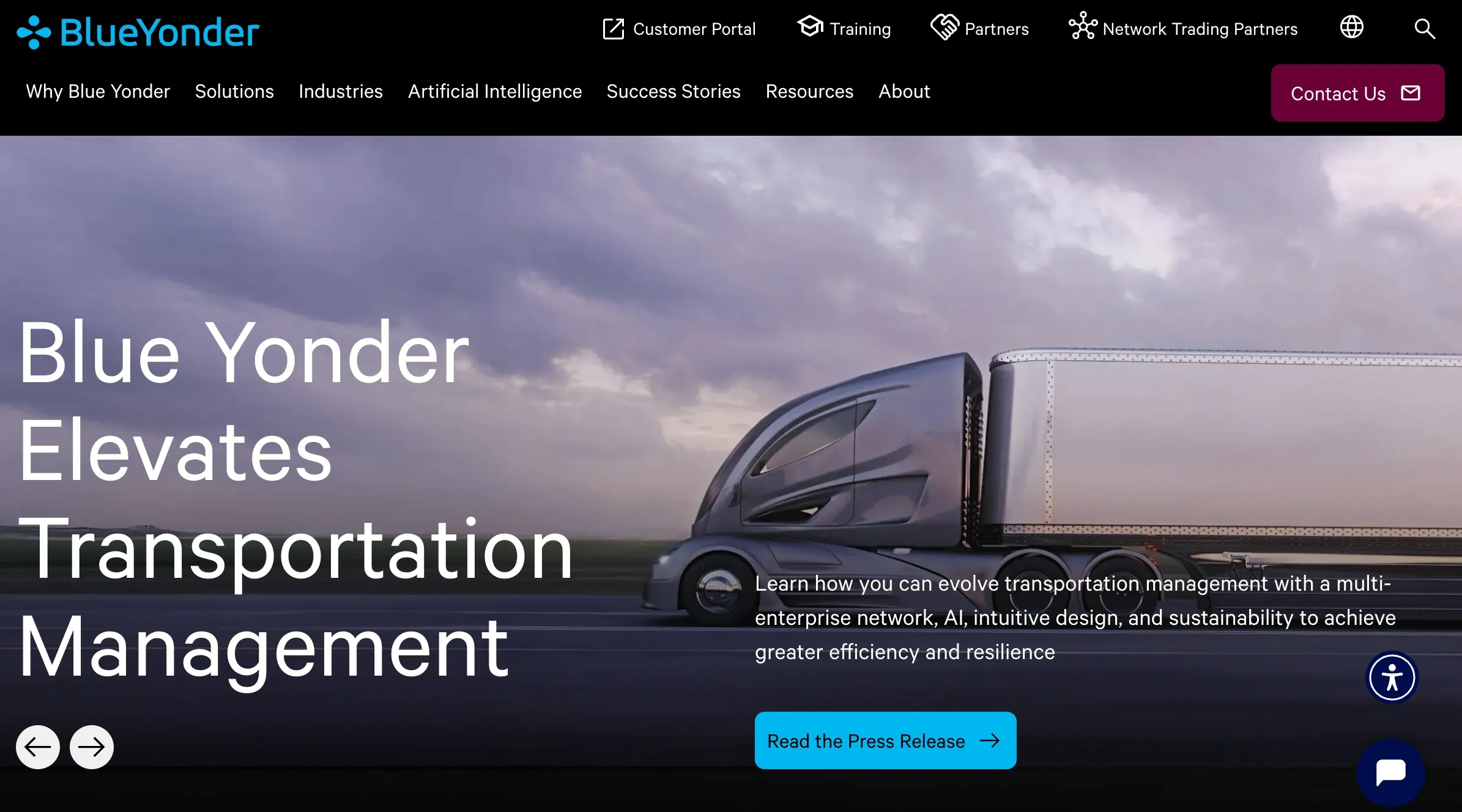
Blue Yonder (formerly JDA Software) is a leading Warehouse Management Software built for large-scale and complex warehouse operations. Its cloud-based system leverages AI and automation tools to deliver real-time visibility, faster fulfillment, and improved logistics optimization across the supply chain.
Features
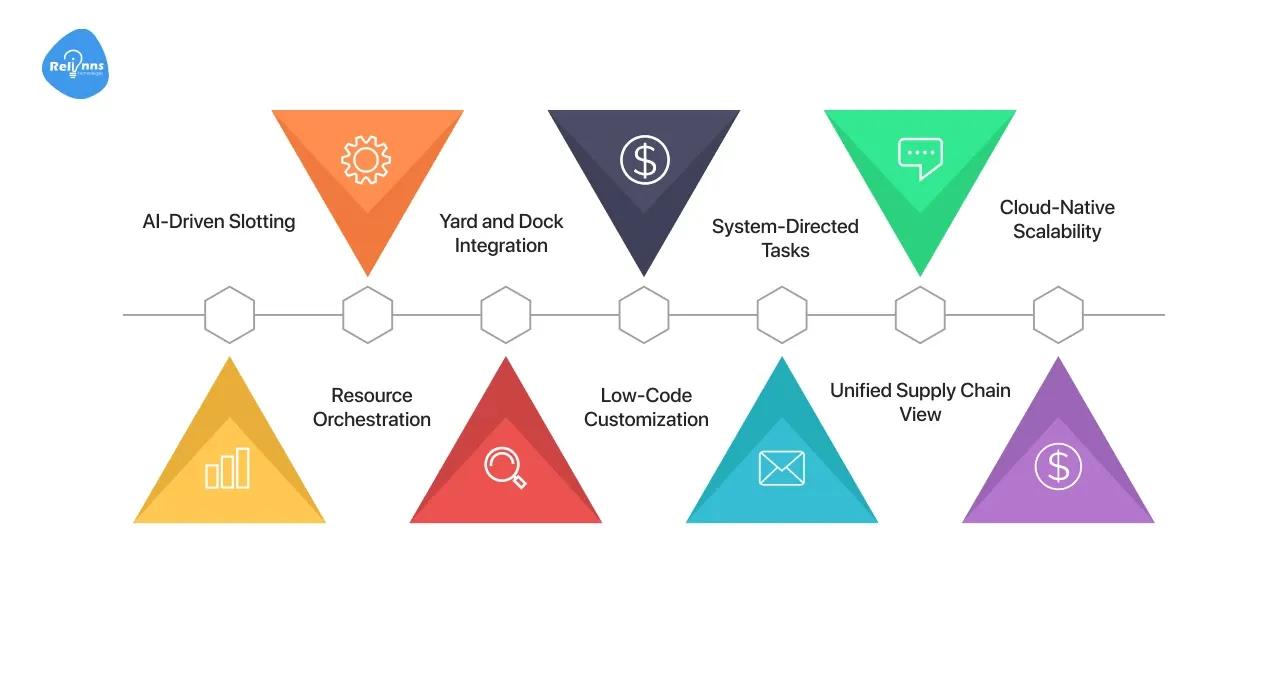
- AI-Driven Slotting: Predicts optimal product placement to boost efficiency.
- Resource Orchestration: Coordinates labor, robotics, and workflows in real time.
- Yard and Dock Integration: Connects warehouse and yard operations for faster turnaround.
- Low-Code Customization: Enables warehouse customization with low-code/no-code.
- System-Directed Tasks: Automates picking, replenishment, and inventory moves.
- Unified Supply Chain View: Integrates with logistics software and supply chain software for complete visibility.
- Cloud-Native Scalability: Offers seamless upgrades and flexible deployment.
Pros
- Predictive Insights: AI tools forecast inventory demand and slotting patterns.
- Custom Workflows: Supports personalized warehouse customization through low-code tools like Joget and Mendix.
- Cloud Flexibility: Scales easily with a secure, cloud-based system.
Cons
- Complex Setup: Implementation requires experienced teams.
- Steep Configuration Needs: Requires heavy customization and setup for non-standard workflows.
- Training Curve: Advanced features may need additional onboarding.
Pricing
Blue Yonder uses a custom quote pricing model based on deployment size, modules, and integration needs.
Rating: 4.1/5
2. By Infor
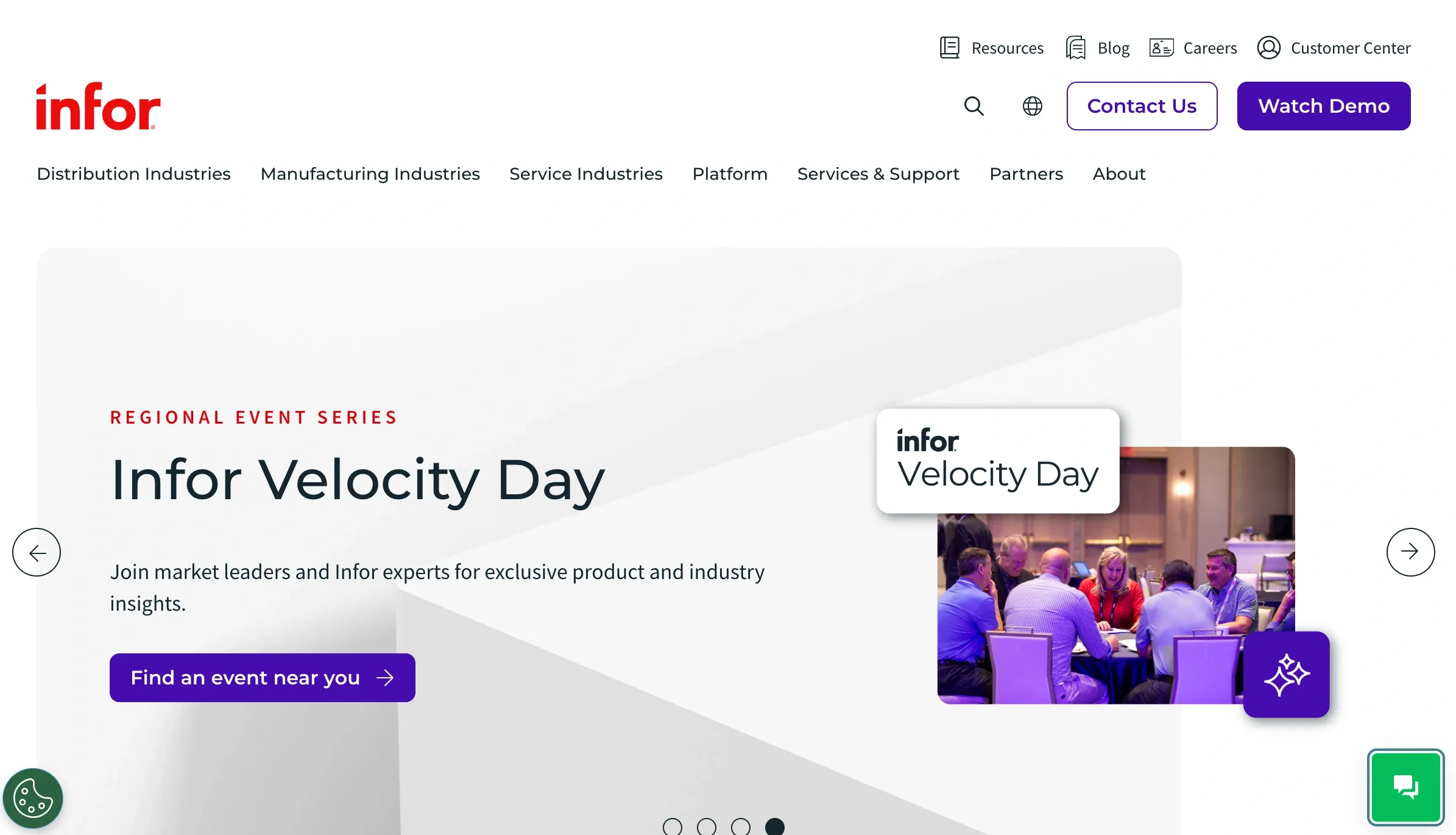
Infor WMS is a cloud-based warehouse management solution built for distributors, manufacturers, and 3PLs. It combines AI, 3D visualization, voice processing, and embedded analytics to modernize operations across the supply chain. The platform supports everything from logistics optimization and order fulfillment to warehouse customization for multi-site management.
Features
- 3D Warehouse Visualization: Enables real-time virtual mapping of warehouse layouts.
- Voice-Directed Picking: Supports hands-free order picking to improve accuracy.
- AI-Based Slotting: Predicts ideal product placement for faster retrieval.
- Labor Management: Monitors team productivity and optimizes task distribution.
- 3PL Multi-Tenancy: Manages multiple clients and warehouses under one platform.
- Integration with Infor Nexus & TMS: Seamlessly connects with logistics software for complete visibility.
- Cloud & On-Premise Flexibility: Offers adaptable infrastructure to suit business needs.
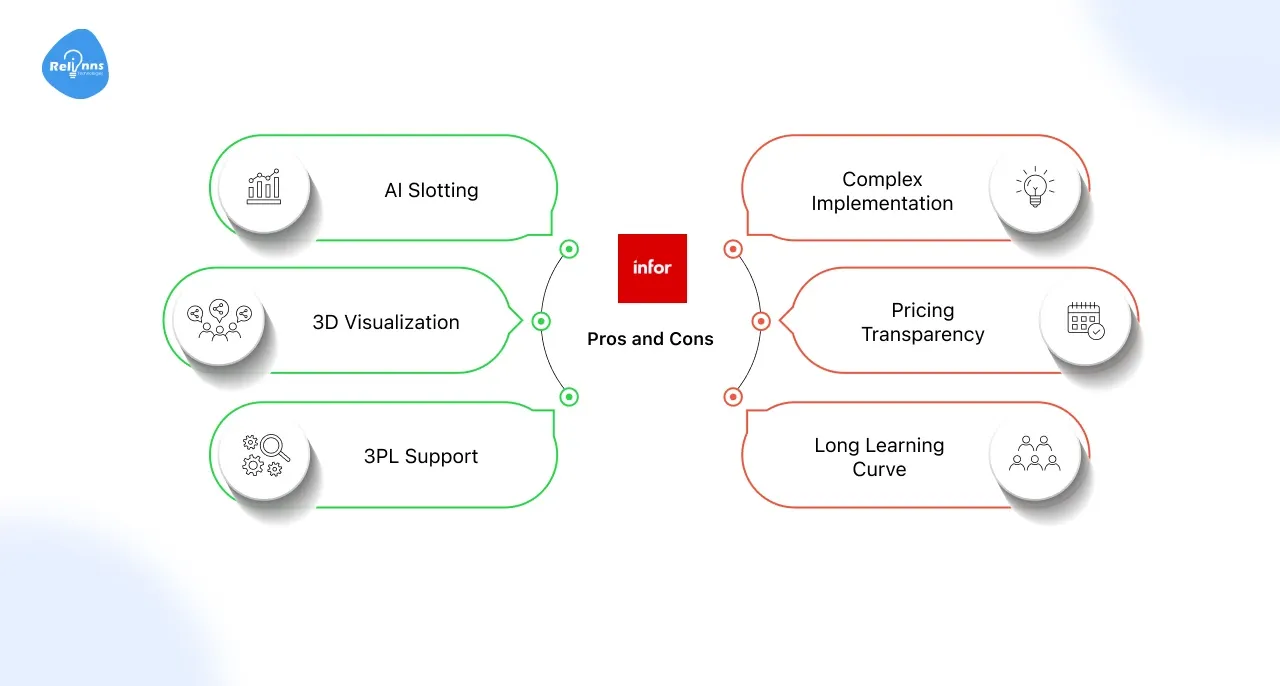
Pros
- AI Slotting: Uses predictive analytics to reduce pick times.
- 3D Visualization: Enhances spatial planning and warehouse insight.
- 3PL Support: Ideal for multi-warehouse and shared logistics environments.
Cons
- Complex Implementation: Configuration requires technical expertise.
- Pricing Transparency: Exact costs are only available via quote.
- Long Learning Curve: Some advanced tools need extensive user training.
Pricing
Infor WMS offers custom pricing based on modules, user count, and other requirements.
Rating: 5/5
3. Fishbowl
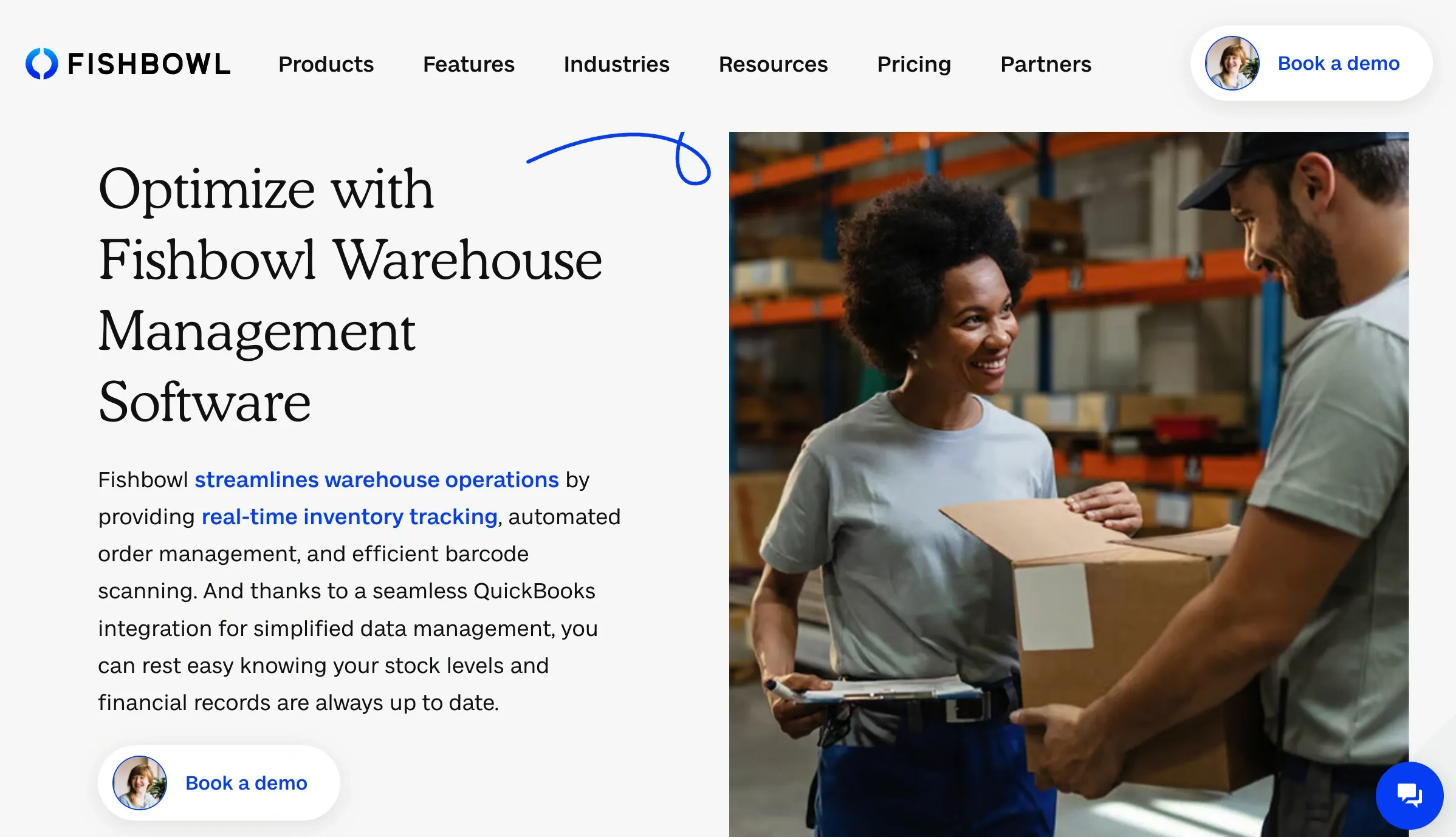
Fishbowl is a hybrid Warehouse Management Software that blends deep inventory management with warehouse operations. It’s robust for small to mid-sized businesses tied to accounting systems, offering real-time tracking, barcode workflows, and integrated order fulfillment.
Features
- Barcode & QR Scanning: Simplifies tracking and item identification in real time.
- Automated Reordering: Generates purchase orders when inventory hits preset thresholds.
- Packing & Shipping Tools: Standardizes packaging and supports carrier integrations.
- ShipExpress Integration: Connects with major carriers like FedEx, UPS, and USPS.
- Fishbowl Go Mobile App: Enables warehouse updates and scanning from any device.
- QuickBooks & Xero Sync: Keeps financial and inventory data aligned automatically.
- Multi-Warehouse Support: Manages inventory across several locations simultaneously.
Pros
- Seamless Accounting Integration: Works smoothly with QuickBooks and Xero.
- Mobile Efficiency: Offers real-time updates through the Fishbowl Go app.
- Workflow Automation: Reduces manual errors with built-in automation tools like Joget workflow.
Cons
- Complex Setup: Requires initial configuration and staff training.
- Limited Report Customization: The flexibility of reporting could be improved.
- Limited Forecasting Tools: Forecasting features are weak, making future demand planning harder.
Pricing
Fishbowl pricing starts from $199/month and can reach up to $699/month. You can also choose a custom plan as per your requirements.
Rating: 4.0/5
Suggested Reading: Build an Inventory Management Software: Complete Guide
4. Zoho Inventory
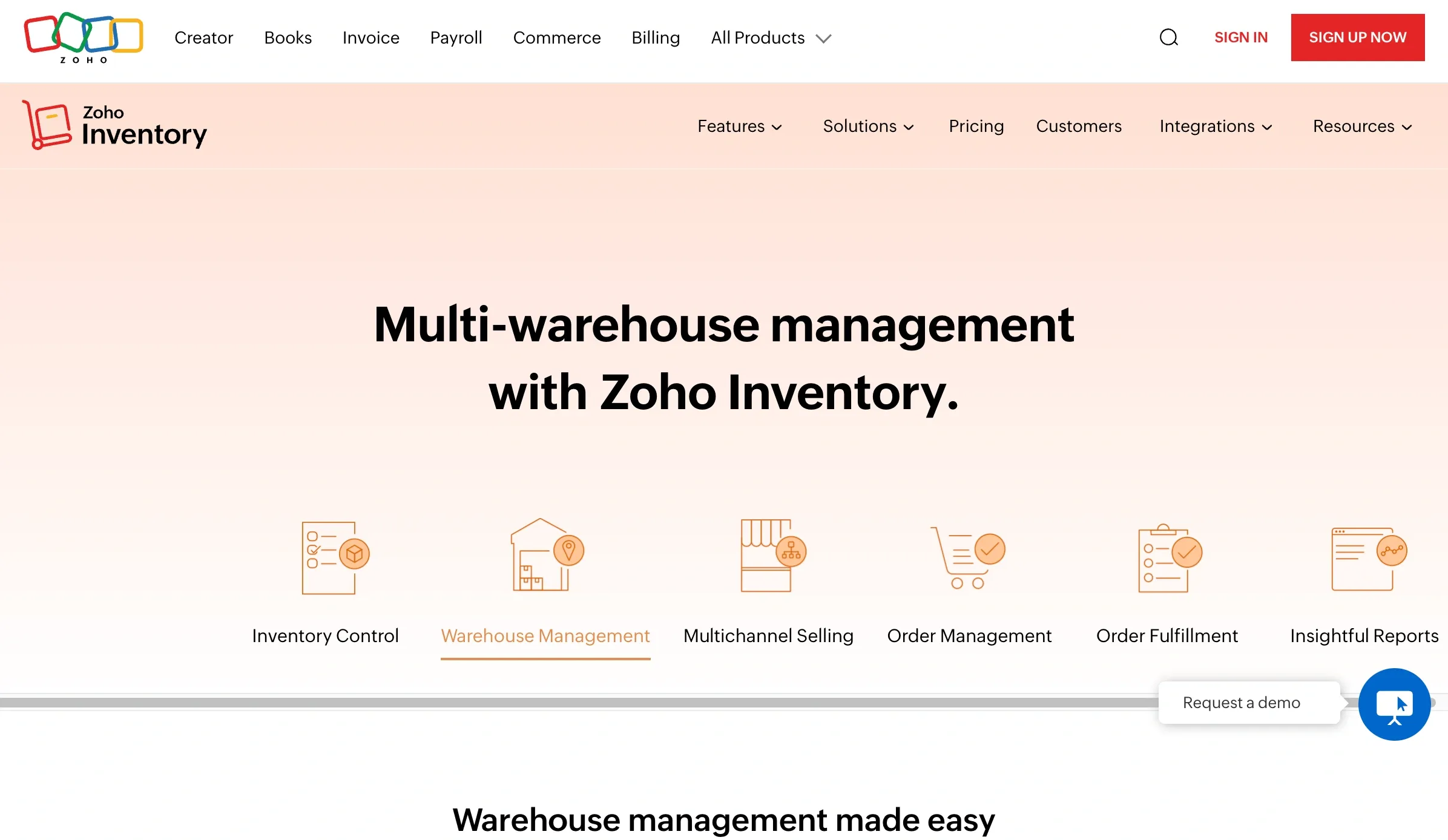
Zoho Inventory is a cloud-based system that manages stock, orders, and shipments across multiple channels and warehouses. It’s built for small to mid-sized businesses wanting better control over inventory, order fulfillment, and delivery tracking without complexity. Known for its clean interface, seamless integrations, and automation, Zoho Inventory helps businesses stay organized and efficient without the complexity of enterprise systems.
Features
- Multi-Channel Sync: Automatically updates stock across online stores and sales channels.
- Barcode Management: Generates and scans barcodes to speed up warehouse operations.
- Batch & Expiry Tracking: Tracks products by batch or expiration date for accuracy.
- Custom Fields & Modules: Personalize orders, invoices, and workflows with ease.
- Carrier Integrations: Connects with 50+ shipping partners for real-time delivery tracking.
- Multi-Warehouse Support: Monitors stock across multiple locations in real time.
- Workflow Automation: Automates reorder alerts and approval processes to reduce errors.
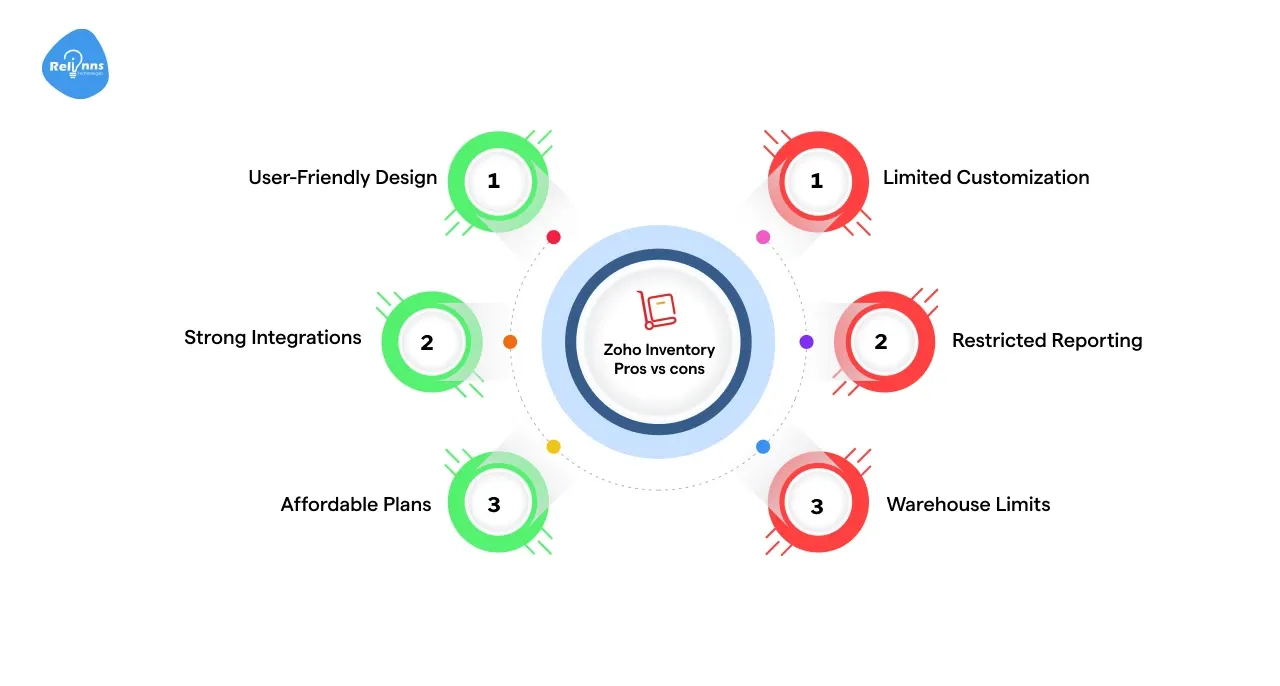
Pros
- User-Friendly Design: Easy setup with an intuitive interface and fast onboarding.
- Strong Integrations: Connects smoothly with Zoho Books, Shopify, Amazon, and more.
- Affordable Plans: Flexible pricing to suit growing business needs.
Cons
- Limited Customization: Advanced tools are available only in higher plans.
- Restricted Reporting: Limited custom report capabilities.
- Warehouse Limits: Lower-tier plans cap the number of warehouse locations.
Pricing
Zoho Inventory offers four main plans: Standard- $39/month, Professional - $99/month, Premium - $159/month, and Enterprise - $299/month.
Rating: 4.3/5
5. Extinsiv 3PL Warehouse Manager
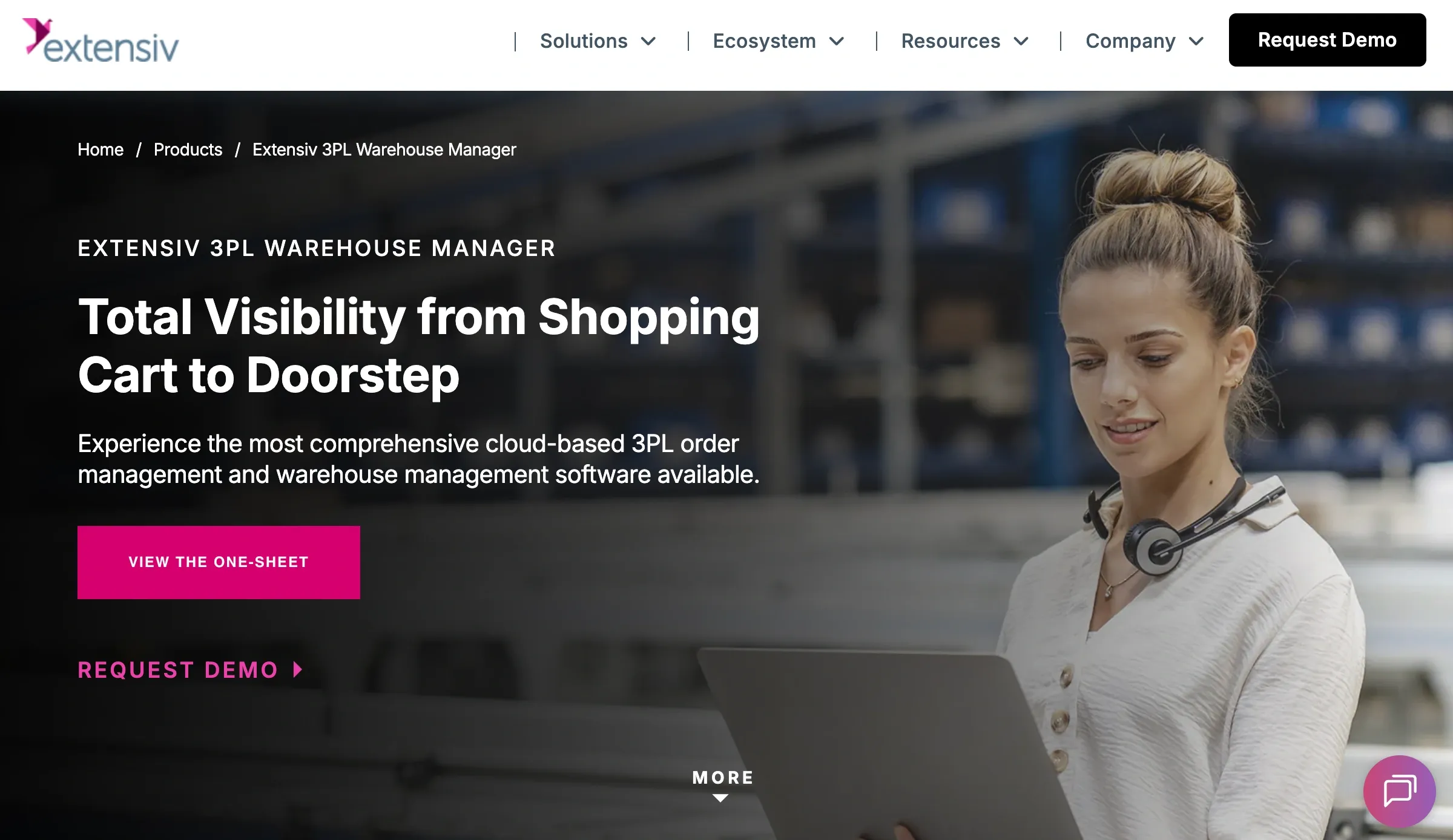
Extinsiv 3PL Warehouse Manager is a cloud-based Warehouse Management Software tailored for 3PLs. It combines inventory control, order fulfillment, and client billing into one system, enabling multi-client operations with transparency. The system offers strong integrations, real-time visibility, and automation to simplify operations at scale.
Features
- Client Portal Access: Enables customers to track orders and inventory in real time.
- Automated Billing Engine: Generates invoices automatically for multiple clients.
- EDI & API Integrations: Connects with major ERPs, eCommerce, and logistics software.
- Mobile Barcode Scanning: Enables real-time picking, packing, and putaway operations.
- Carton & Pallet Optimization: Suggests best packing configurations for faster shipping.
- Multi-Warehouse Management: Easily handles multiple facilities and client accounts.
- Analytics Dashboard: Provides insights into warehouse performance and utilization.
Pros
- Client Transparency: Clients get real-time visibility through a self-service portal.
- Automated Billing: Built-in logic for recurring and event-based billing.
- Integration Ready: Works seamlessly with EDI, eCommerce, and ERP systems.
Cons
- Order Volume Performance Issues: High batch sizes can significantly slow down order processing.
- Complex Setup: Requires time to configure for multi-client operations.
- Limited Customization: Advanced tailoring may need extra development.
Pricing
3PL Warehouse Manager uses a custom pricing model, typically starting from $100–$1,000/month, depending on warehouse size and volume. Account management fees covering document storage, shipping labels, and tracking reports are usually around $35/month.
Rating: 4/5
6. Ascent WMS
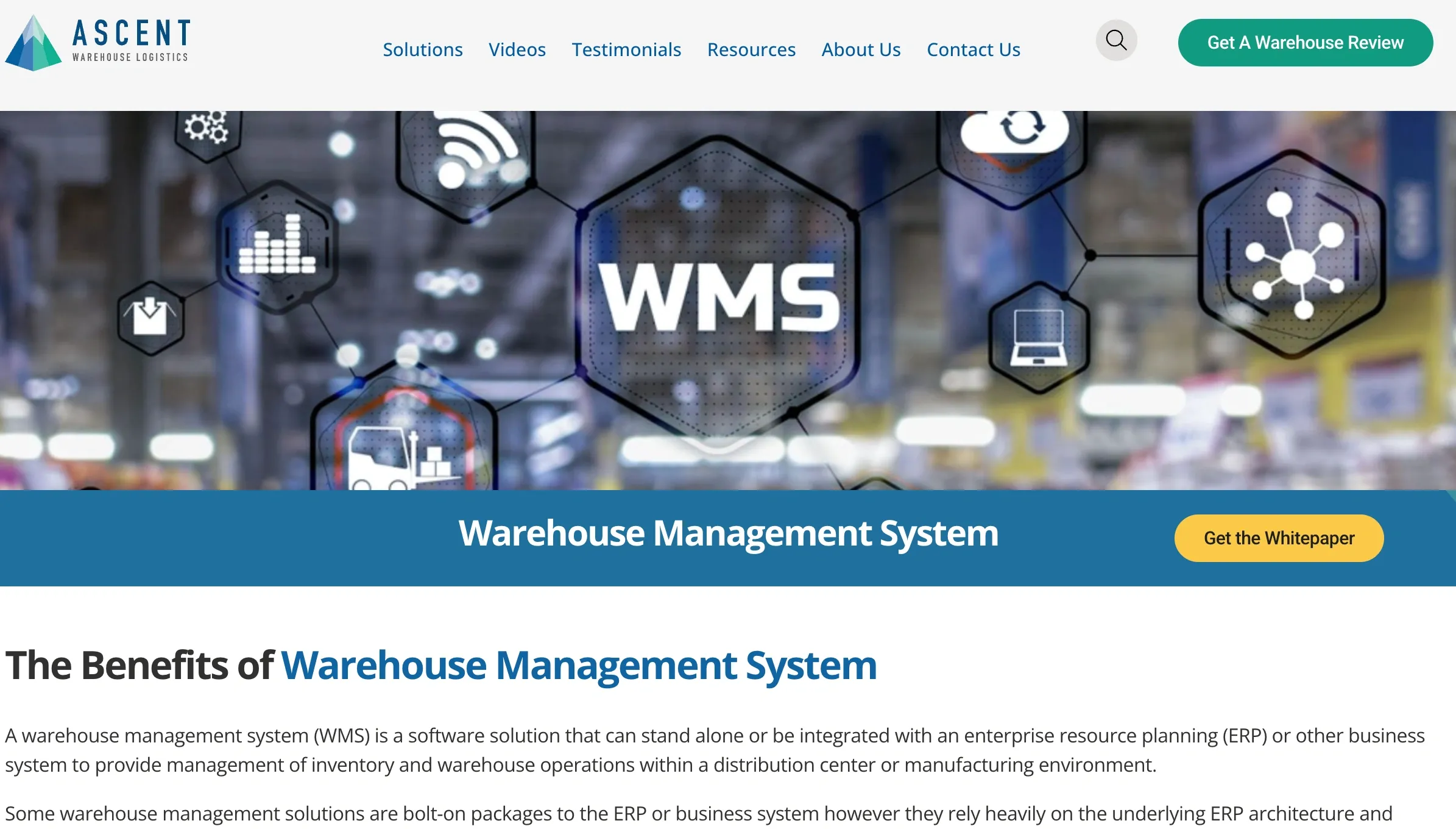
Ascent WMS or Ascent Warehouse Logistics (AscentWL) is a modular Warehouse Management Software designed for advanced and automated warehouse environments. It combines Warehouse Execution Systems (WES) and Warehouse Control Systems (WCS) to manage everything from order picking and replenishment to robotics and conveyor systems.
The platform helps medium to large-scale warehouses streamline operations, improve efficiency, and integrate seamlessly with automation tools.
Features
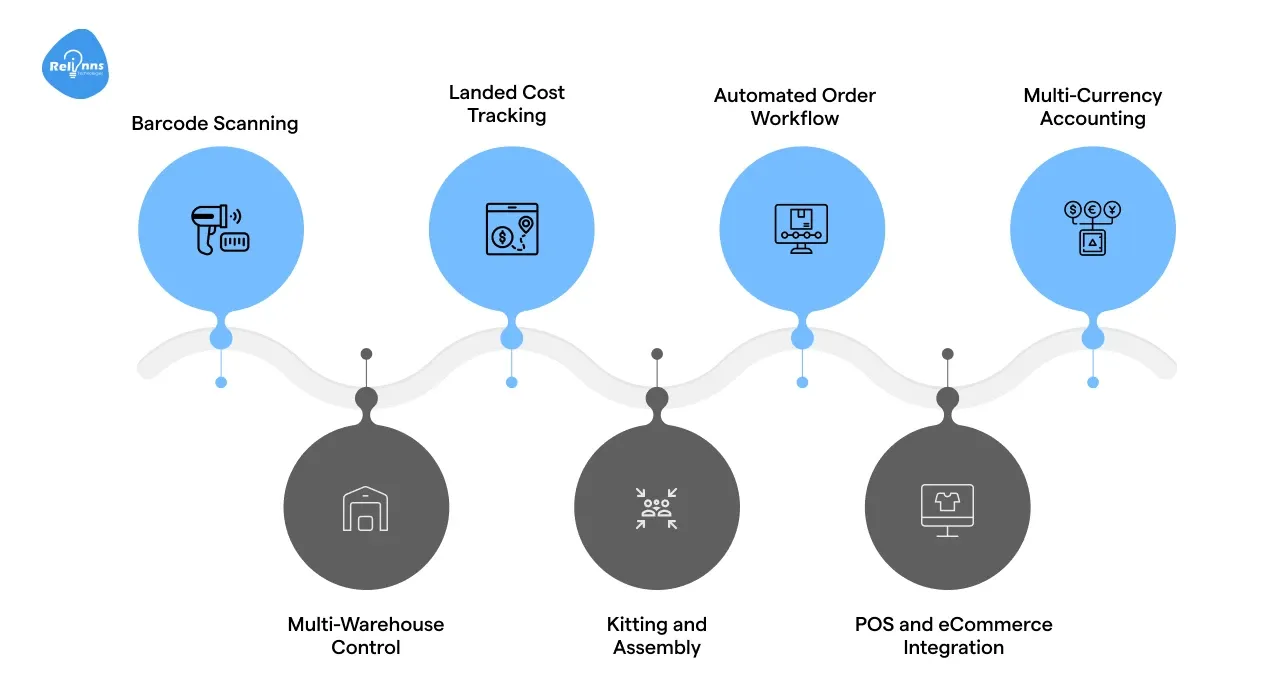
- WES/WCS Integration: Manages and controls conveyors, ASRS, and robotics directly.
- 3PL Management: Supports multi-client workflows and reporting for 3PL operations.
- Wave & Replenishment Planning: Optimizes picking and restocking schedules.
- Task Interleaving: Combines tasks to reduce idle time and increase productivity.
- Labor & Productivity Tracking: Monitors performance metrics for warehouse staff.
- Dynamic Storage Configuration: Customizes rack, bin, and media configurations.
- Advanced Automation Interface: Connects with automated systems for real-time control.
Pros
- Advanced Automation Control: Integrates seamlessly with ASRS and conveyor systems.
- Modular Flexibility: Add or scale WES, WCS, and WMS modules as operations grow.
- Optimized Implementation: Standard modules reduce deployment time.
Cons
- Best for Large Warehouses: May exceed the needs of smaller facilities.
- Complex Integration Setup: Connecting with automation hardware or legacy systems often requires specialist expertise.
- Steeper Learning Curve: Complex features need trained users to operate efficiently.
Pricing
Ascent WMS offers custom pricing based on warehouse size, automation level, and chosen modules.
Rating: N/A
7. Blue Link ERP
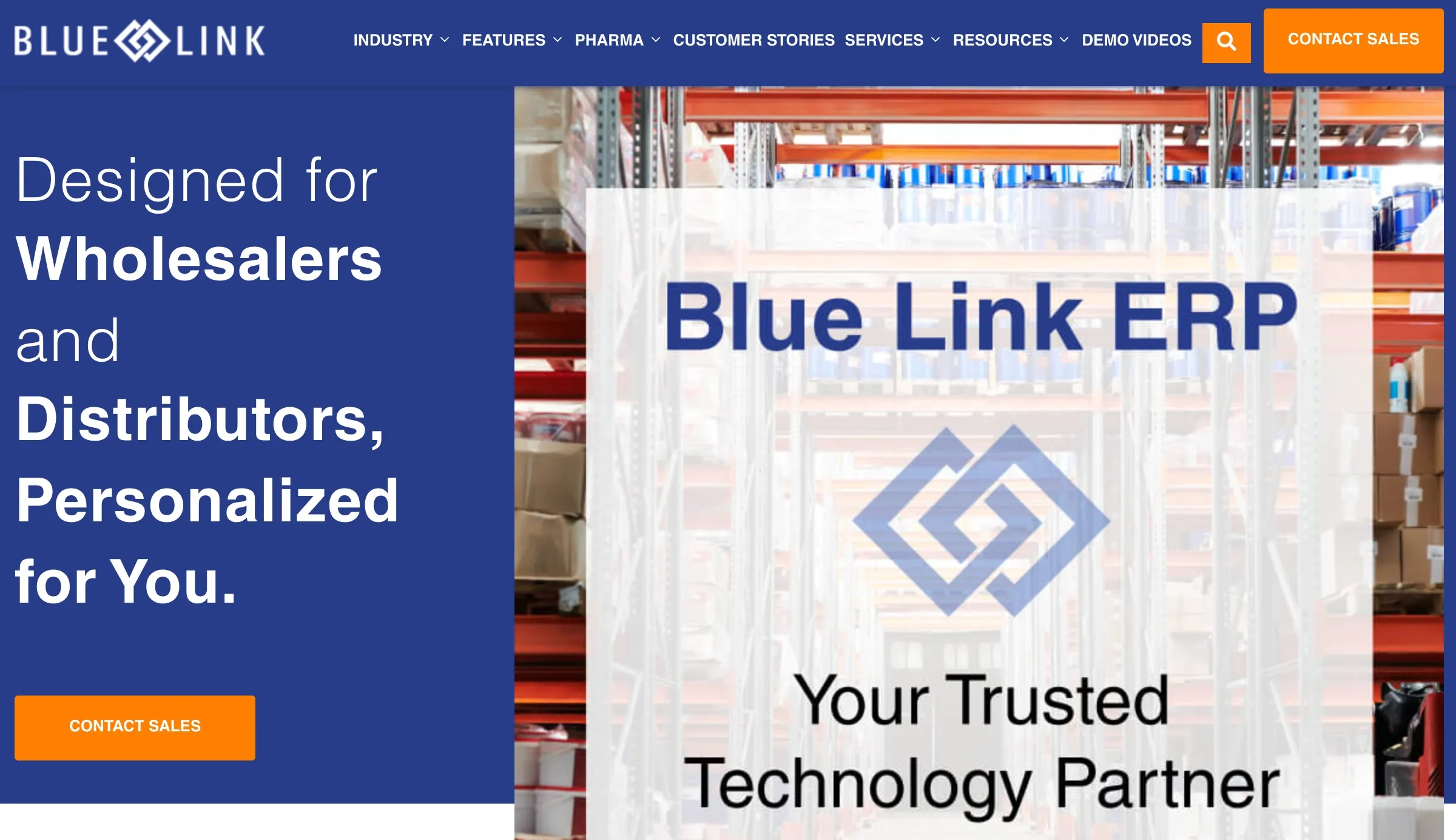
Blue Link ERP is an all-in-one ERP and Warehouse Management Software built chiefly for wholesalers and distributors. It integrates inventory management, accounting, order processing, and warehouse workflows into a unified system. The platform supports barcode scanning, multi-location control, and optional modules like POS and landed cost tracking.
Features
- Barcode Scanning: Enables accurate order picking and stock verification.
- Multi-Warehouse Control: Manages stock across multiple warehouse locations.
- Landed Cost Tracking: Calculates total cost including freight, duty, and import fees.
- Kitting and Assembly: Supports bundling and Bill of Materials (BOM) management.
- Automated Order Workflow: Streamlines order creation, approval, and fulfillment.
- POS and eCommerce Integration: Connects retail and online sales to warehouse data.
- Multi-Currency Accounting: Simplifies global transactions and reporting.
Pros
- Unified Platform: Combines accounting, warehouse, and inventory in one system.
- Flexible Modules: Offers scalable add-ons like POS and landed cost features.
- Strong Customer Support: Users report quick response and onboarding help.
Cons
- Outdated Interface: The Design feels less modern compared to newer systems.
- Limited Report Customization: Custom reports require additional setup.
- Occasional System Lag: Users report slower response times when handling large transaction volumes.
Pricing
Blue Link ERP starts from approximately $1,800 - $4,200/annually for Basic, $12,000 - $60,000/annually for Mid-Tier, and $250,000 - many millions/annually for Top-Tier, with pricing varying based on modules, user count, and implementation needs.
Rating: 3/5
8. Epicor BisTrack
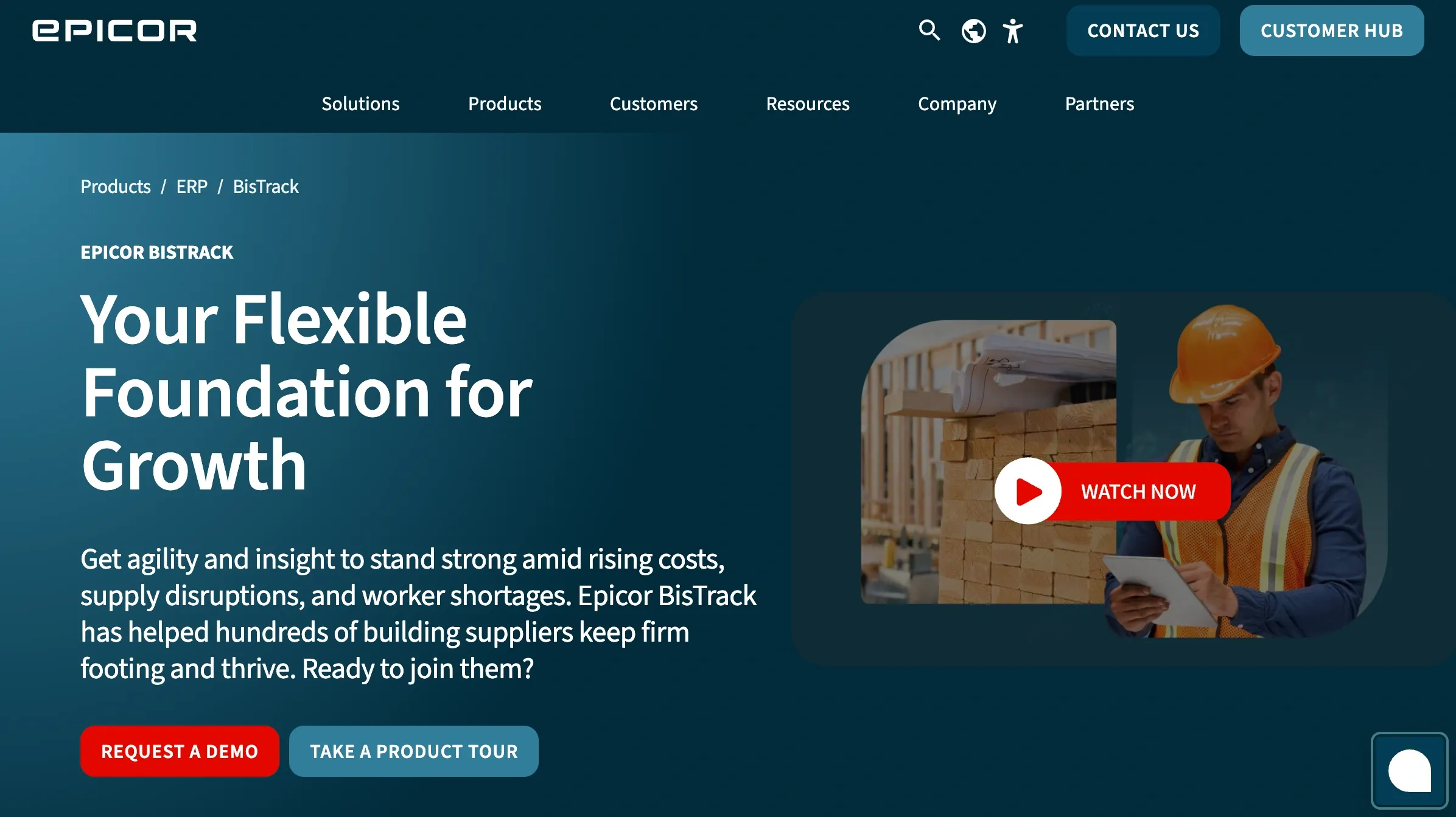
Epicor BisTrack is a specialized Warehouse Management Software and ERP solution designed for the building materials, lumber, and distribution industries. It integrates inventory control, order fulfillment, finance, and warehouse operations into a single, connected system. With powerful analytics, automation, and multi-branch support, it helps distributors improve productivity, visibility, and decision-making.
Features
- Real-Time Inventory Sync: Updates stock levels instantly as goods are shipped or received.
- Lot and Serial Tracking: Manages products by batch, serial, and expiration data.
- Advanced Picking Options: Supports single, batch, and zone picking methods.
- Built-in Analytics: Delivers role-based dashboards and real-time warehouse metrics.
- Role-Specific Interface: Customizes workflows for sales, warehouse, and accounting teams.
- Mobile Access: Allows barcode scanning and updates from handheld devices.
- Multi-Branch Management: Enables centralized control for multiple locations.
Pros
- Industry-Specific Design: Optimized for lumber, building, and supply distribution.
- End-to-End Integration: Links warehouse, accounting, and supply chain functions.
- Data-Driven Insights: Includes built-in BI dashboards and reporting tools.
Cons
- Slower Performance: Frequent lag and slow application speed under load are reported.
- Complex Navigation: The user interface is seen as unintuitive, making it easy to get lost across modules.
- Weak Accounts Receivable Tracking: Difficulty tracing payments to invoices, especially during audits.
Pricing
Epicor BisTrack follows a custom pricing model based on modules, number of users, and deployment type.
Rating: 4.2/5
Why Choose Warehouse Management Apps?
Choosing the right Warehouse Management Software can completely change how your warehouse operates.
These tools simplify everyday tasks, cut down errors, and make your entire operation more efficient.
Here’s why businesses are turning to warehouse apps today.
Efficiency Gains via Digital Design
Using digital twins to simulate and optimize warehouse layouts has helped companies improve operational efficiency by 20–25 % before making any physical changes.
Cost Reduction Potential
A bottom-up “cleansheet” cost-analysis across hundreds of warehouses revealed that many operations run significantly above ideal costs; by addressing inefficiencies, firms can capture 15–20 % in cost improvements.
Better Inventory Management
Warehouse apps provide real-time visibility into stock levels, locations, and movement. With live updates, you avoid stockouts, reduce overstocking, and improve inventory control accuracy across all locations.
Productivity & Response Improvements
In a warehouse automation retrofit use case, a regional grocer achieved 20 % run-rate savings, 4× higher productivity, 15–20 % faster response times, and 20 % decrease in space usage.
Optimized Warehouse Layout
With built-in warehouse logistics design and customization features, you can plan space efficiently. This helps streamline picking routes and boost warehouse optimization delivery performance.
Seamless Logistics Planning
Integration with logistics software and supply chain software keeps your warehouse connected to every part of your business. From delivery tracking to route optimization, your entire logistics flow stays in sync.
Integrated logistics and inventory systems are key to efficiency. Discover how Relinns built one unified platform in this Inventory Management System Case Study.
Reduced Manual Errors Through Automation
Automation tools minimize data entry mistakes, speeding up reporting, inventory updates, and communication. Using custom software and cloud-based systems, teams can work faster and make decisions confidently.
In short, warehouse apps bring structure, speed, and control to every corner of your operations.
Conclusion: How Does Relinns Build Custom Warehouse Apps?
Efficient warehouse operations depend on systems that fit the way your business actually works. The software options discussed show how features like inventory tracking, order fulfillment, and logistics planning simplify complex workflows. But for many businesses, pre-built tools can’t fully match their unique processes and growth goals.
That’s where Relinns Technologies comes in. The team builds custom warehouse management apps that connect every part of your supply chain, integrating automation tools, real-time data, and cloud-based systems for smoother, faster operations.
Why Partner with Relinns
- 25% faster deployment with low-code, customizable warehouse app solutions.
- Inventory accuracy powered by IoT and RFID-based real-time tracking.
- 30% lower operational costs through smart automation and AI-driven optimization.
- Built-in OSHA, EPA, and ISO compliance for faster, safer audits.
- This is a scalable architecture that adapts to business growth and multi-site operations.
- 24/7 expert support ensuring uninterrupted performance and reliability.
If you’re ready to make warehouse management more straightforward and smarter, Relinns can help you build it your way.
Frequently Asked Questions (FAQ's)
How does warehouse optimization help?
Warehouse optimization in Warehouse Management Software improves inventory flow, reduces idle time, and enhances logistics planning. By integrating automation tools and analytics, operations become faster, more efficient, and cost-effective.
What makes delivery logistics software effective?
Effective Logistics Software integrates real-time delivery tracking, order fulfillment, and inventory control in one platform. It automates routing, minimizes delays, and boosts customer satisfaction through more intelligent logistics optimization.
How does warehouse design impact logistics?
An efficient Logistics Warehouse Design improves movement, space utilization, and order fulfillment. Strategic layouts powered by supply chain software reduce travel time and increase picking accuracy across the facility.
Why customize your warehouse management?
Warehouse Customization ensures your system aligns with unique workflows, product types, and business models. Custom-built cloud-based systems improve scalability and support seamless integration with existing inventory management tools.
What trends are shaping warehouse management in 2025?
Modern Warehouse Management Softwares now use AI, IoT, and robotics to enhance logistics optimization. These innovations in custom software accelerate Warehouse Optimization, Delivery and ensure real-time visibility across the supply chain.


